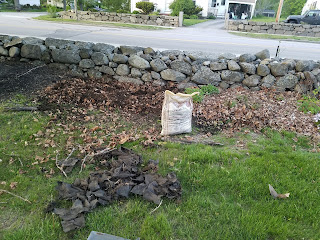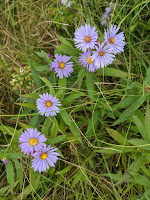Using Leaf Mulch!!!
It is 4 degrees out today and it does not feel right to write about flowers or caterpillars, so I want to share one of the successes of creating habitat for insects I had in 2018 using all of my excess maple leaves as an alternative to bark mulch. According to the National Wildlife Federation, using leaves for mulch is critical to many butterflies and other species of insets, including luna moths, great spangled fritillaries, woolly bear caterpillars (which become Isabella tiger moths) and red-banded hairstreaks. These are just examples. Insects need a place where they can escape predators, the sun and certainly the cold weather. They also forage for bacteria, fungi and detritus that exists in decomposing leaf material.
 So in the fall of 2017, I decided to start taking control of the yard I purchased the year before because the landscape was all barren bark mulch. Nothing really lives in the bark mulch. It is all carbon with few nutrients and no real structure to create habitat where bugs could hide, regulate temperature and forage. It also creates an environment where only the invasive colonizing plant species can take hold. This means that you spend a ton of time weeding out invasive colonizers that can survive in a low nutrient environment, which is a never ending battle and I needed to change my relationship with my garden because I did not have time to fight the endless defeat against weeds.
So in the fall of 2017, I decided to start taking control of the yard I purchased the year before because the landscape was all barren bark mulch. Nothing really lives in the bark mulch. It is all carbon with few nutrients and no real structure to create habitat where bugs could hide, regulate temperature and forage. It also creates an environment where only the invasive colonizing plant species can take hold. This means that you spend a ton of time weeding out invasive colonizers that can survive in a low nutrient environment, which is a never ending battle and I needed to change my relationship with my garden because I did not have time to fight the endless defeat against weeds.
My solution was to rip out the mulch, remove the hidden landscape fabric I found which was suffocating tree roots and preventing plants from reaching the mineral soil. In the fall I put a 6 inch layer of maple leaves down to insulate the ground, reduce water consumption because I was spending a small fortune on municipal water to keep my plants happy. The look is a little different as you can see. It does not have the uniform dark color of dyed mulch that people instinctively associate with a well tended garden. But once sunflowers, zinnias, joe pye and other plants came up, what you see is the flowers and plant structure. To keep weeds out, I stopped tilling the soil and pushed the leaves aside to plant the seedlings into the soil.
 The results were a fantastic success: I was able to cut the frequency of watering to 25% of what it was before due to the leaves forming a protective layer that prevented the sun and wind from drying out the soil. That was a huge savings on my water bill, not to mention all the organic bark mulch I did not need to buy. I hardly did any weeding the entire summer of 2018 compared to the prior year.
The results were a fantastic success: I was able to cut the frequency of watering to 25% of what it was before due to the leaves forming a protective layer that prevented the sun and wind from drying out the soil. That was a huge savings on my water bill, not to mention all the organic bark mulch I did not need to buy. I hardly did any weeding the entire summer of 2018 compared to the prior year.
I also noticed hundreds of bugs, which I call 'soldier beetles' coming out in the spring in the areas where I used leaf mulch. I'm not really sure what role these guys play in the garden and landscape ecology, but they are just one indicator of a return to nature that comes when you integrate your gardening into the landscape and use natural processes. Keep in mind that these changes occurred in 2018, when I only started using the leaf mulch in the fall of 2017. This means that butterflies and insects did not have much of an opportunity to recognize and use this habitat. This year, here is to hoping that their eggs, larvae and even adults are buried in the leaf mulch under all this frozen snow, waiting for spring to come. Everyone loves leaf mulch! Don't you?
 So in the fall of 2017, I decided to start taking control of the yard I purchased the year before because the landscape was all barren bark mulch. Nothing really lives in the bark mulch. It is all carbon with few nutrients and no real structure to create habitat where bugs could hide, regulate temperature and forage. It also creates an environment where only the invasive colonizing plant species can take hold. This means that you spend a ton of time weeding out invasive colonizers that can survive in a low nutrient environment, which is a never ending battle and I needed to change my relationship with my garden because I did not have time to fight the endless defeat against weeds.
So in the fall of 2017, I decided to start taking control of the yard I purchased the year before because the landscape was all barren bark mulch. Nothing really lives in the bark mulch. It is all carbon with few nutrients and no real structure to create habitat where bugs could hide, regulate temperature and forage. It also creates an environment where only the invasive colonizing plant species can take hold. This means that you spend a ton of time weeding out invasive colonizers that can survive in a low nutrient environment, which is a never ending battle and I needed to change my relationship with my garden because I did not have time to fight the endless defeat against weeds.My solution was to rip out the mulch, remove the hidden landscape fabric I found which was suffocating tree roots and preventing plants from reaching the mineral soil. In the fall I put a 6 inch layer of maple leaves down to insulate the ground, reduce water consumption because I was spending a small fortune on municipal water to keep my plants happy. The look is a little different as you can see. It does not have the uniform dark color of dyed mulch that people instinctively associate with a well tended garden. But once sunflowers, zinnias, joe pye and other plants came up, what you see is the flowers and plant structure. To keep weeds out, I stopped tilling the soil and pushed the leaves aside to plant the seedlings into the soil.
 The results were a fantastic success: I was able to cut the frequency of watering to 25% of what it was before due to the leaves forming a protective layer that prevented the sun and wind from drying out the soil. That was a huge savings on my water bill, not to mention all the organic bark mulch I did not need to buy. I hardly did any weeding the entire summer of 2018 compared to the prior year.
The results were a fantastic success: I was able to cut the frequency of watering to 25% of what it was before due to the leaves forming a protective layer that prevented the sun and wind from drying out the soil. That was a huge savings on my water bill, not to mention all the organic bark mulch I did not need to buy. I hardly did any weeding the entire summer of 2018 compared to the prior year. |
| Everyone loves leaf mulch! |




Comments
Post a Comment